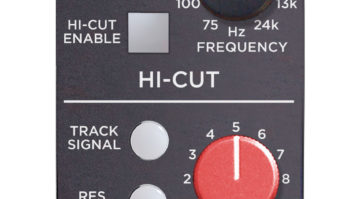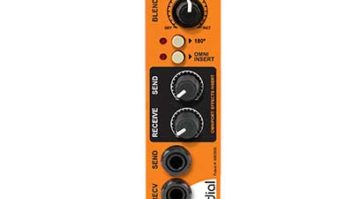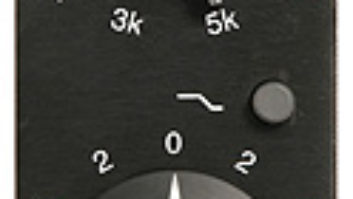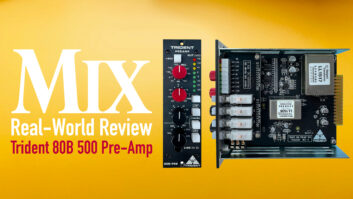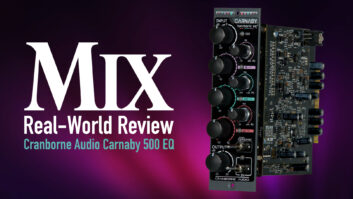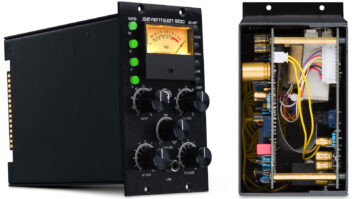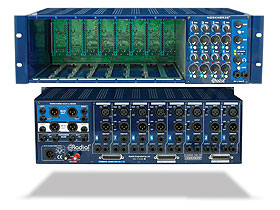
The Radial Workhorse 500 offers eight 500 Series card slots.
The Workhorse 500 also features an 8-channel mixer.
Radial Engineering has a knack for creating practical, solidly built, problem-solving gear for stage and studio that are both innovative and fairly priced. The company’s DIs, reampers, splitters, switchers and acoustic stabilizers come in a variety of configurations that offer engineers plenty of creative options. In this lineage, the Workhorse 500 takes two simple ideas and marries them in a single unit. The Workhorse is an 8-channel mixer with panning, main, monitor and headphone outs, housed in an 8-slot, 500 Series rackmountable unit.
ZOOMING IN
What takes the Workhorse beyond your standard 500 Series rack are the little extras that expand the interactivity between the mixer and rack modules. For instance, on the back of the unit, the I/O sections for each card slot includes a Feed switch that takes the output of one unit and sends it internally to the input of the next unit over. I used this with great results with preamp/compressor combinations using modules from three manufacturers. Each module can also feed the mixer internally (with reservations), and the Omniport uses a ¼-inch TRS plug on the back of each module section and extends the capabilities of each module, depending on its function. For instance, when used with a Radial PowerPre, the Omniport acts as an instrument input.
Some features (like units auto-feeding the mixer and the Omniport) are only available on modules developed for the Workhorse or purchased from Radial; other features work as advertised across all manufacturers’ modules. For example, the Stereo Link option allowing odd/even modules to work in tandem on odd/even slots operates in standard API master/slave configuration. In addition, the ¼-inch TRS input and output on each module works with any unit
In addition to the standard XLR and TRS I/Os, the Workhorse also supports 8-channel, balanced D-Sub I/O for all card slot I/Os, and there is another D-Sub that lets you feed eight channels of balanced audio directly to the mixer for summing. Finally, the Workhorse also includes external lugs on the back for setting up a star-grounding scheme in high-end installs.
THE MIXER
The Workhorse mixer is a clean machine providing low-noise operation and a solid design using Jensen transformers on the main output. Each channel offers an on/off switch, panner, confidence meter and rotary level control that feeds the main output bus, monitor bus (both switchable on/off) and the volume control for the dual headphone outs, which carries a mono/stereo toggle. The main and monitor output section uses balanced XLR or ¼-inch TRS connectors, with the main out featuring an unbalanced TRS insert, To move beyond 8-channel summing/mixing capability, the expansion bus allows you to strap two or three units together for 16×2 or 24×2 operation via ¼-inch TS cable.
PLAYING NICELY WITH OTHERS
I was able to test a variety of Radial’s 500 Series modules with the Workhorse, as well as modules from other manufacturers. During a variety of sessions, I used a pair of Millennia’s HV-35 preamps; the Magnum preamp, Brute optical compressor and Vogad VCA compressor from Inward Connections; Grace Design’s m501 preamp; and the DACS MicAmp 500. (See the accompanying reviews of four 500 Series modules.) Once I loaded up the rack with a variety of components, my first wish was that all third-party companies accommodated the Workhorse’s added feature set. Although essential operations such as in/out work as promised, I missed the Omniport, Link function and ability to feed the mixer internally. Alas, all features are not always available when using third-party modules.
ON THE BENCH
The Workhorse’s mixer was put to the test using an APx525 audio analyzer with great results. The first trial run was to run signal through a Radial PowerPre at mic level and then out at +4 dBu. The signal was automatically fed to the mixer on the same channel number, then out of the mixer at +4 dBu and back into the APx525, which read S/N at a very respectable 87 dBu. To see what happens at the extreme, the preamp gain was raised until the first red light was lit (before clipping). The mixer’s channel output was also maxed, providing 49 dBu of total gain at the mixer’s output, which tested well again at 0.004 THD+N.
CAN DO!
The Radial Engineering Workhorse 500 certainly lives up to its name. It is a versatile tool for live and studio use. I found it easy to get excited about using 500 Series modules with the Workhorse—I used the Feed switch often and liked how individual modules worked within the unit’s framework. The mixer is superclean; I wouldn’t hesitate to use it as my main summing mixer out of my DAW.
I only had two negatives come up during my time with the Workhorse. One involved the new Millennia HV-35 preamp, which would not fit into the Workhorse without removing the HV-35‘s outer steel housing. A call to Millennia revealed that its units do work with the API Lunchbox but hadn’t been tested with the Workhorse. A look at the manual revealed that slots 1 through 4 are set up for single-wide modules while 5 through 8 are double-wide. I was able to fit the HV-35 with its outer housing on the double-wide slots without a problem. Also, the card tray can be completely removed if the need arises.
Another third-party module issue came up with the Grace Design m501 preamp. Instead of using standard 500 Series rack-screws, Grace went with longer hex screws that proved difficult when trying to thread them into the Workhorse. In both cases, I was able to work around the problems, but be aware that 500 Series modules are manufactured by a range of companies and aren’t tested across all platforms.
Despite these minor issues, the Workhorse is a great unit and reasonably priced for what it offers. The feature set is deep, the system is scalable, construction is solid and it sounds great. What’s not to like?
Kevin Becka is
Mix
’s technical editor.

Click on the Product Summary box above to view the Workhorse 500 product page.

Inward Connections Magnum Preamp/DI
The newly retooled Magnum Preamp from Inward Connections features two VF600 all-discrete amp blocks, balanced Cinemag input/output transformers and 80 dB of gain. Magnum has the usual features onboard such as DI input, polarity flip and phantom power, plus three highpass filters (70/100/200 Hz). Gain is adjusted in 5dB increments, plus a 0 to 10dB output level trim for fine tuning. All switches are solid, and the unit is built like a tank. I was lucky to have Inward’s Vogad VCA compressor and Brute Optical Limiter on hand, which rocked in combination with the Magnum. The Magnum/Brute combo was my favorite overall, offering plenty of great transformer-colored gain tastefully crunched by the Brute on both vocals and guitars. The Brute is easy to operate and very musical with no pumping. Where the Brute is an “up is more” type of gain reducer, the Vogad is a full-featured compressor offering rotary controls for ratio, threshold, output gain, attack, release, HPF (250 Hz) and a 10-segment LED meter. These units are easy to love.
I used the Magnum on kick drum (Beta 52), snare (SM57) and vocal (SE Voodoo VR1) with excellent results. You can definitely hear the punch the transformers offer on drums, which were solid. The downside for me on this unit is the lack of any kind of metering. And while this is not a deal-breaker, it would be nice to see at least a signal-present indicator for peace of mind when troubleshooting. (Inward is soon releasing a version of Magnum with a VU meter.)
Besides the lack of metering, the Magnum sounds great and is a solid contender for your high-end preamp needs. At $825, it’s expensive but is justified based on the sonics and build. It sounded great across a range of applications, especially high-transient recordings like kicks, toms and snares. Personality-plus are the two words in play here. If you’ve got the ducats, the Magnum would be a preamp any engineer would relish.
—Kevin Becka

Grace Design m501 500 Series Preamp/DI
Grace Design’s foray into creating products for the 500 Series is the m501 preamp, a vertical version of its m101 preamp. The unit is priced at $625, streets at $545 and boasts super-clean transformerless design with nearly flat operation up to 72 kHz. Features include gain control in 5dB increments from 10 to 65 dB and a 0 to 10dB rotary trim pot, switchable highpass filter (75 Hz, 6dB/octave), Ribbon mode and phantom power, the last three each carrying a confidence LED. There is a two-stage LED level meter with the green threshold at -12 dBu; red kicks in at +16 dBu. There is also a hi-Z input on the front offering a quick solution for instrument recording.
I used the m501 on a range of applications with great results, including on kick (miked with a Royer R101), snare drum (SM57) and powering an AKG 414 recording a hi-hat. The Ribbon mode is brilliant. Its relay bypasses the phantom power–coupling capacitors, kills phantom power and ups the input impedance from 8.1 k-ohm to 20 k-ohm. When the ribbon light was on, I could rest assured my mic was safe.
My only gripe with the unit is the mounting system. Instead of standard 500 Series rack-screws, the m501 comes with longer hex-key screws to accommodate the thicker faceplate. While the design ethic can’t be challenged (it looks fantastic), I’d rather have deeper counter-sunk holes allowing the use of standard screws. Not only does it necessitate carrying a tiny hex wrench around, the screws didn’t want to sit in the standard screw slots without applying a lot of pressure. While I did have a problem using standard screws with the Radial Workhorse, Grace claims that standard screws can be used with the API Lunchbox, Purple and Atlas 500 Series racks..
That said, the Grace m501 is a solid, great-sounding and clean preamp at a fair price. How clean is it? My APx525 audio analyzer revealed an unbelievable 100dB S/N ratio. If you’re looking for a lot of color, don’t go here, but if you want a pristine preamp with lots of gain, this is your box.
—Kevin Becka

DACS MicAmp 500 Preamp
DACS MicAmp 500 is operationally styled after DACS’ MicAmp 2 horizontal rack preamp with minimal differences in the circuitry. Features include gain in 4dB increments, with a rotary trim pot offering 0 to 8 dB of additional gain. The phantom-power switch bypasses the input capacitors when defeated, and the three-stage highpass filter can be set to flat, 30 Hz and 80 Hz. The four-stage LED meter kicks in at -15 dB, +5 dB, +13 dB and Over.
I used the MicAmp 500 on a number of sessions on a drum kit and guitar amp, and it did sound very good. However, on low-level applications like acoustic guitar, it did have a bit of noise when I boosted the gain to the upper ranges available. My APx525 audio analyzer revealed an 80dB S/N ratio, the poorest noise performance of any of the preamps tested here. In service, the preamp represented transients very well and sounded smooth in most applications.
Although I liked the sound of the MicAmp 500, I did have a few reservations. For $1,122, I would expect a DI input and a few more features. I found the LED meter annoyingly slow during tracking, and missed having a pad. For instance, I used the MicAmp 500 to power an SM57 on a snare drum and was always riding dangerously close to distortion, even with the level and trim set to its lowest setting. If I needed to bring down the gain in a situation where I was using a dynamic mic, I’d have to use an inline pad, which is unacceptable. I also think that the settings for the HPF could be better placed at 60 Hz and 100 Hz, for instance, not 30 Hz and 80 Hz. While it’s nice to have any HPF at all, I’d prefer a setting where I could better control the frequency content at the low end. Maybe a two-button scenario that could give you four choices, including flat, instead of a three-position switch?
All in all, the MicAmp 500 is a very good-sounding preamp; however, the price and lack of extended features offered on competitive units costing less may deter all but dedicated DACS fans from jumping onboard.
—Kevin Becka

Radial Engineering PowerPre
The Radial Engineering PowerPre lists for $600, streets at $499 and offers the best metering and feature set of the four preamps tested here. Features include phantom power and polarity flip, plus a Hammond output transformer, -15dB pad, highpass filter (150 Hz), ground lift (rear-mounted) and a two-stage, gentle boost–only EQ called Breath and Punch. The phantom, pad and polarity all carry a confidence LED.
The 10-segment meter is very good with little light leakage between segments. The three-position Vox setting is very usable across a range of applications. I used both Breath and Punch when recording drums and bass with great effect. Punch gently boosts frequencies between 50 and 100 Hz, while Breath does the same between 5 kHz and 10 kHz. Smart design is evident: The phantom power switch is recessed, a DI input is implemented via the Omniport (provided you’re using the Radial Workhorse), there’s a front-mounted XLR mic input and the one-stage “Accustate” gain control automatically optimizes signal-to-noise at all levels.
I used the PowerPre for recording vocals, guitar amps and drums with great results. It is especially good in high-transient, high-SPL situations where you can drive the output hard for more transformer color. My APx525 audio analyzer revealed a respectable 87dB S/N ratio. The single-knob Accustate gain control is smooth and linear. The downloadable manual goes deeper into the mechanics of Accustate and is worth a read.
The downsides? The ground lift works with the front XLR only and is a great feature, but the rear-mount makes it a bit impractical. You could also argue that the front-mounted XLR is redundant, but it does offer a quick plug-and-record option for live and desktop situations. These minor gripes are overcome by the fact that this preamp sounds great, offers much character and visual feedback, and costs less than $500.The PowerPre is an affordable, feature-packed unit that’s a must-hear for anyone shopping for 500 Series preamps.
—Kevin Becka
